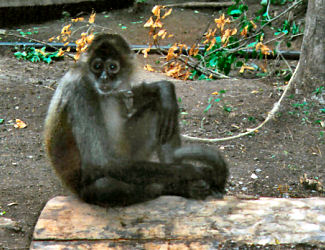Geoffroy's spider monkey / Black-handed Spider Monkey
Ateles geoffroyi
SUBFAMILY
Atelinae
TAXONOMY
Ateles geoffroyi Kuhl, 1820, Nicaragua.
OTHER COMMON NAMES
English: Black-handed spider monkey.
PHYSICAL CHARACTERISTICS
Body coat varies in color from yellow, to red, to black, with black hands and feet. Cheek hairs stand out, and that hair on the top of the head forms a cowl that ends in a triangular crest over the brows.
DISTRIBUTION
Northeast and west coast of Mexico to Panama.
HABITAT
Evergreen rainforest, semi-deciduous forest, mangrove forest.
BEHAVIOR
Multimale, multifemales groups with over 40 individuals routinely split up into smaller foraging parties and are rarely observed together. Males remain in their natal groups, and tend to associate more with one another than with females. Males have hierarchical relationships, but also affiliate more closely with one another than with females. At Barro Colorado Island, Panama, males were observed to engage in fur-rubbing behavior more commonly than females.
FEEDING ECOLOGY AND DIET
Geoffroy's spider monkeys at Santa Rosa National Park, Costa Rica prefer fruit, which comprises over 70% of their annual diet. Chapman found that they adjust the size of their feeding parties to the size of fruit patches. Day ranges average about 4,265 ft (1,300 m), within a home range of 420 acres (170 ha). They may be important seed dispersers of the fruit species they eat.
REPRODUCTIVE BIOLOGY
Ovarian cycles last from 20 to 23 days in length. Birth intervals are about three years, and may be concentrated in more seasonal habitats.
CONSERVATION STATUS
Not listed by the IUCN.
SIGNIFICANCE TO HUMANS
Hunted for meat. |
